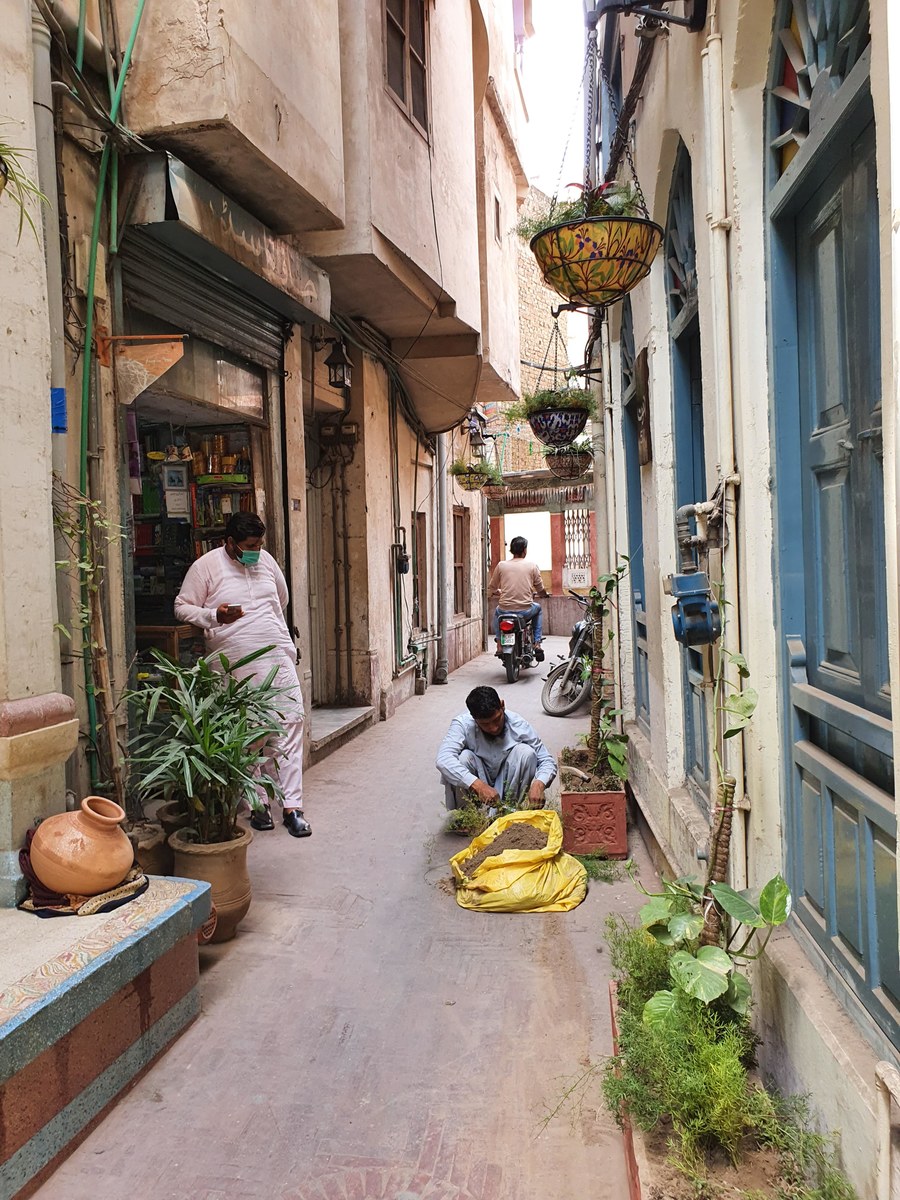LAHORE: With little funding from the Pakistani state or support from the country’s rich, the ongoing renovation of the Walled City of Lahore — home to architectural masterpieces of the Mughal era — may take more than six decades to complete, conservators warn.
Conservation work on some of the key 16th and 17th-century structures on the 260-hectare area that constitutes the historic and cultural heart of Lahore started in 2012, with the Walled City of Lahore Authority (WCLA) established to revive the city’s former glory and attract more tourists. But insufficient funding has meant only the Wazir Khan Mosque, the Shahi Hammam — both built during the reign of Emperor Shah Jahan — and a minor part of the Lahore Fort have been renovated in the last eight years.

This image taken in the Walled City of Lahore on May 28, 2021, shows a street that has been renovated and beautified by the relevant authorities in the city. (AN Photo)
“So far, in eight years, we have been able to complete only 10 percent of the fort’s wall,” WCLA director general Kamran Lashari told Arab News last week.
“With the given pace and flow of money for the conservation of Walled City of Lahore, people may have to wait for more than six decades before they devour the true taste of their glorious heritage,” he said, adding that the project’s annual budget from the provincial government of Punjab was only about Rs30 million ($193,000).

People walk past the 17th century Wazir Khan mosque in the Walled City of Lahore on May 28, 2021. (AN Photo)
Despite the renovation project’s obvious importance to preserve the Mughal masterpieces Lahoris take pride in, the city’s rich and influential have not supported it.
“In other countries, we see that local elites come forward and grant charity for such projects,” Lashari said. “But in Pakistan no one came forward to grant some money for the restoration of this heritage.”
A private party that offered substantial support to the Walled City’s renovation was the Aga Khan Trust for Culture, which documented all of its sites in 2006. Now, Lashari said, it helps the WCLA with technical assistance and professional expertise.

This image shows the interior of Shahi Hamaam that was built in 1635 during Emperor Shah Jahan's reign. (AN Photo)
While the aim of renovation is to save monuments from decay, some critics say the work is changing their original design.
“The goal of the conservator is to stabilize the remaining original artwork and integrate any repairs in order to preserve the artist’s original intent,” said Prof. Ajaz Anawar, renowned painter, art historian and former head of the fine arts department at the National College of Arts (NCA) in Lahore.

This image shows the artifacts displayed in the 17th century Wazir Khan Mosque in the Walled City of Lahore on May 28, 2021. The mosque was commissioned during the reign of Mughal Emperor Shah Jahan. (AN Photo)
“The present look does not correspond with the colors and themes used in the Mughal era,” he said, citing bright colors that were not used in the 17th century. “I studied art in Italy, we can’t redo the artwork inside monuments.”
The old city’s inhabitants, however, say they are happy since the renovated sites attract more visitors and extend a lifeline to small businesses.

People walk past Shahi Hamaam or the Royal Bath in Lahore's Walled City on May 28, 2021. The place is a Persian-style bath that was built in 1635 during Emperor Shah Jahan's reign. (AN Photo)
“The WCLA is working toward the socio-economic welfare of the people as well,” the authority’s media coordinator, Tania Qureshi, said, adding that WCLA also gave jobs to locals at conservation sites.
Replicas of restored buildings and artworks inside them are now the main chunk of the local souvenir industry.

This image taken in the Walled City of Lahore on May 28, 2021, shows the sitting area in the courtyard of Shahi Hamaam that was built in 1635 during Emperor Shah Jahan's reign. (AN Photo)
“Tourists and foreigners buy these artifacts which are replicas of artwork done inside Wazir Khan Mosque,” one of the sellers, Amjad Deewari, said.
The project, which has included improvements in local infrastructure, has contributed to improving the living conditions of the old city’s residents.

This image shows the exterior of Sunheri Masjid or Golden Mosque that is currently under construction in the Walled City of Lahore on May 28, 2021. (AN Photo)
“We are happy, our streets are no more bulging out sewerage water,” Ijaz Rasul, a 70-year-old resident of the Walled City, told Arab News. “Our surroundings are now clean, houses are painted, and further decay of old houses has been taken care of.”


















